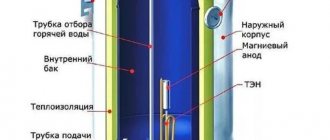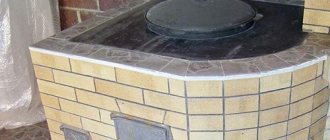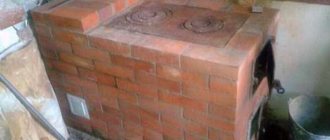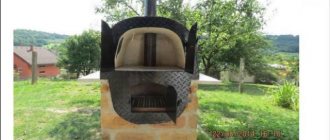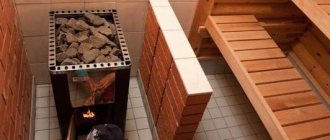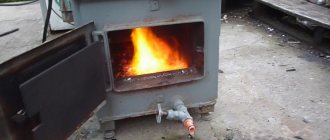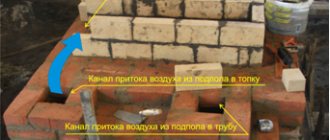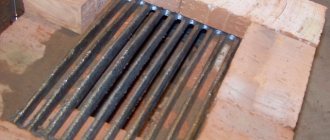For every summer resident, a stove is an excellent help in the household, as well as an opportunity to warm up in winter and provide the family with tasty and healthy food all year round.
Our ancestors also knew all the healing properties of the Russian stove: they washed, cooked in it, dried mushrooms and berries on it, warmed themselves on a stove bench, and so on. The stove has always been the heart of the house, regardless of its size: a small one with only a hob, or a real Russian stove with a stove bench - it could say everything about its owner!
The stove is used both as a winter heating option and as a summer heating option, intended only for cooking.
There are many different “modern” versions of the stove on the Internet, but if you want to give the room a “zest,” then it is better to leave the ethnic rustic style and preserve the flavor that the master tried to bring to his work. The Russian stove was usually installed in Russian-style huts. But it can be converted into a smaller one by removing only the bed.
You can repair a brick stove with your own hands. Thus, you will not only significantly save your budget, but will also be able to avoid mistakes that irresponsible craftsmen often make.
- 2 Useful tips
- 3 Heating in the house
- 4 Restoration and decoration
- 5 Types of faults and their repair
Detection of knockout bricks
Quite often, before repairing a brick kiln, it is necessary to determine whether there are knock-out bricks that can cause a malfunction of the entire structure. To find them, you need to do the following:
- first you need to carefully inspect all smoke ducts of the structure;
- usually the knockout bricks protrude a couple of millimeters and are easy to see;
- After this place has been found, you should carefully remove all the mortar around it, and then remove the brick. If there is open access to the channel, then the bricks can be easily removed. If not, then only a professional master can help;
- if the removed element is intact and has no cracks or other defects, then it is necessary to prepare fresh mortar and install the brick in its place.
Why are fallen bricks so dangerous? This is the first sign of destruction of the chimney and the stove itself, so it is not enough to simply put all the elements in place, you need to additionally carefully inspect the structure, and then plan a major repair. If this is not done, then the structure may simply not survive the next heating season. In addition, such a stove, which is already collapsing, is very dangerous and is not recommended to be used.
Replacement of damaged bricks and removable cast iron elements
During the operation of a brick kiln, there is often a need to replace burnt out or damaged bricks. To do this, you need to remove the damaged brick, and completely clean the place where it was located from all sides of old mortar and soot and thoroughly moisten it with water. Then put a new mortar on the bottom layer of the masonry, lower the inserted brick into water for a couple of seconds, put a layer of mortar on top and sides of it and insert it into the formed niche.
One of the most common types of repairs for brick stoves is strengthening or replacing its cast-iron elements: combustion and view doors, grate and, in fact, the stove. The easiest thing to do here is to replace the grates. Since the grate is laid without clay mortar, it is enough to simply remove the old grates, having first carefully examined how they were laid, and put new ones in their place in the same way.
Often, when operating a brick oven, the cast iron stove is damaged. Today, their quality leaves much to be desired, and with constant alternation of heating and cooling, the material, unable to withstand it, bursts into two or even more pieces. The same can happen due to improper installation of the stove. But it is also possible that a slab in a dacha or in a house can still be used, but due to damage to the bricks on which it is laid, it has lost the necessary support, and cracks have appeared between the brick and the slab.
In the first case, you need to replace the stove with a new one. But we must keep in mind that the slabs may differ in size. When purchasing a new stove, do not forget to accurately measure the dimensions of the old one. The new slab should be the same in size as the old one, at most 10-15 mm larger, but in no case smaller. Otherwise, instead of simply replacing the stove, you will have to redo the entire firebox.
In the second case, there is no need to purchase a new slab, but you will have to replace the damaged bricks of the top row, or, even more reliably, replace the entire top row of bricks.
You can use a carpenter's ax to remove the old slab. The ax blade is inserted from the side under the slab and, using the ax handle as a lever, it is lifted. Then do the same on the other side of the slab. After this, the plate can be easily removed.
The method of replacing damaged bricks was discussed above. Relaying the top row is carried out according to the same principle: first, the old bricks are carefully removed. Here the technology is simple: drive a thin but wide blade of a chisel or chisel under the brick from below (you can also use a knife with a wide blade), pull the handle and tear the brick out of place, after which it is easy to pull it out. You need to start with the most damaged brick, since the first brick is the most difficult to tear off. Then they do the same with the second brick and take them all out one by one.
The surface of the bricks of the bottom row is thoroughly cleaned of clay mortar and soot, thoroughly moistened with water and a new row of bricks is placed on top, observing, of course, their dressing. When installing the stove, you need to remember that cast iron tends to expand when heated, so under no circumstances should the stove be firmly fixed.
It’s easier if a new slab is placed in place of the old one and matches it in size. In this case, the place where the slab will be placed is cleaned of any remaining clay mortar and soot, the slab is installed and the cracks are sealed with freshly prepared mortar. If the slab is placed on new bricks, then you must first make a recess in them along the perimeter of the slab, and the dimensions of the recess on each side should be 5-7 mm larger than the dimensions of the slab; Place a slab in the recesses and seal with freshly prepared mortar.
http:
Features when repairing the firebox
Most often, the firebox is damaged when it is made of ordinary red brick, rather than fireclay. The brick delaminates and falls off in plates. How to repair a brick stove in this case? There is no point in covering and reinforcing red brick; it still crumbles from high temperatures. Since it is impossible to reduce the temperature level in the firebox, additional lining must be made to reduce the effect of temperature on the walls.
The internal lining of the firebox is made using the following materials:
- Cast iron. It will last a long time. But there is one trick: you need to leave a gap between the wall and the cast iron. To do this, they lay corrugated cardboard, which will burn immediately during the first fire and will burn out, but the gap will remain.
- Steel. For that. To repair with steel. It is also necessary to make a gap. But the steel will still burn out quite quickly, especially if the repair is carried out in a sauna stove.
- Fireclay brick SHA-6 (“fly”). It is capable of serving without splitting under prolonged loads of extreme temperatures. A gap of 1 cm is left between this brick and the wall using basalt cardboard. The solution is taken the same as when laying fireclay. After repairing the stove using a firebox lining, the rate of heating of the room will be reduced, but the temperature inside the firebox will be higher. Combustible gases burn out completely.
- Fireclay brick. You can repair a damaged firebox using ordinary fireclay bricks placed on edge. True, it will reduce the combustion space; the gap between it and the wall will also have to be maintained.
- Vermiculite boards. Such slabs are environmentally friendly, do not emit harmful fumes, are made entirely of natural material, and are highly fire resistant.
- Superizol (calcium silicate). When the question arises of how to repair a furnace firebox with your own hands, it is worth considering this safe material of mineral nature. It can easily warm up to 1000 degrees.

How to cover up cracks: stages of work
When the solution is ready, you can begin to cover up the defects.
The steps for repairing cracks are as follows:
- preheat the oven (until warm, not hot);
- the cracks are widened;
- thoroughly cleaned from dust and dirt;
- be sure to moisten with plenty of water;
- cover with the prepared solution.
Further heating is possible only after the solution has completely dried. But this should be done at most halfway through the fuel load. After the fuel has burned in the “light” mode, you can heat the stove as usual.
Attention: it is better not to simply cover the cracks in the brickwork with mortar, but to first lay them with asbestos cord. When working with asbestos, you must use a protective mask.
Thus, to learn how to repair a brick stove with your own hands, you must study the procedure and composition of the solution.
You need to know this
Before you start sealing the seams, you need to prepare them: remove residual clay, rinse thoroughly with water using a brush, then prime with heat-resistant glue (50% solution is suitable). When grouting joints, you need to ensure that the repair mixture fills the joints completely, leaving no voids. If a gap is too large in the masonry, in addition to the mixture, you also need to place a ceramic cord into it. Due to its physical properties, it not only withstands open fire, but also very high temperatures - over 1000 degrees.
Ceramic cord is often counterfeited, so before purchasing it, you need to hold a lit match or lighter to it to evaluate the heat resistance of the product. The cord is placed in the masonry seams around the perimeter of the cast iron slab, using heat-resistant glue for fixation.
To protect stove parts that do not need repair, they must be covered with masking tape.
Plastering the stove
There are cases when an unplastered stove in a country house becomes covered with so many cracks that it is impossible to repair it with ordinary plastering. To extend its service, you will need to tie the stove frame with metal wire:
- Channels with a depth of 15-20 mm are cut horizontally in the furnace.
- The groove must be made in such a way that it encircles the entire frame of the stove.
- After laying the steel wire, it must be tensioned; this is done in several places using a beard or a thick nail. You need to stop in time so as not to cause a wire break.
- After this, the stove must be plastered.
You should know that any plastered stove will last longer than an unplastered one.
Types of faults and their repair
Let's look at the most common cases when furnace repair is simply necessary:
- The appearance of smoke and carbon monoxide in the room. Smoke in brickwork can be attributed to minor repairs. In order to “patch up” the stove, use rich red clay or a special mixture that is sold in construction stores. It is necessary to coat the oven when it has cooled down to allow the clay to dry evenly.
- A crack on one of the furnace walls. This situation can be corrected by rebuilding the entire furnace structure. Furnace repair should begin with dismantling the upper part of the structure. After you have disassembled the top, look at the base: if it is not cracked and has a smooth structure, does not bend, without changes, then you can leave it. For temporary use, secure the stove with a metal belt and seal the gap with mortar. Just remember that such a belt cannot be adjacent closely, as the metal may burst when heated.
- No traction. The case is rare and is explained by a bend or the appearance of cracks in the chimney pipe. The pipe must be moved slightly at an incline. If you have 2 stoves with one pipe for removing soot, then you need to make a “bridge”.
Please note: good draft is ensured by proper construction of the stove, as well as compliance with all construction standards.
- The fire in the new stove goes out. This phenomenon indicates that the oven is not properly dried. It is necessary to open all the doors and ventilate it. Then you should begin gradually calcining the stove, increasing the temperature and the amount of firewood.
- The brick inside the firebox cracked. This indicates that the brick in the combustion chamber was heated unevenly or that there was a sharp temperature difference. Correct the situation by sealing the chips with a clay solution and then drying thoroughly.
- A door or other metal part has broken off. As a rule, metal parts are “fitted” into the furnace structure with pins, even at the construction stage, and it is almost impossible to get them with minimal losses. The door can only be replaced by completely disassembling the oven (use a respirator to protect yourself from dust getting into your respiratory tract).
The costs for repairing a furnace include the following items:
- dismantling the old stove;
- purchase of new bricks, metal parts (if it is impossible to use old ones);
- acquisition of all related tools (construction level, tape measure, small hammer, trowel for laying mortar, trough for mixing mortar);
- delivery and unloading of construction materials.
Repairing an old
stove with your own hands is much cheaper than building a new one, because you will save on paying a specialist.
It is important to know: you need to take care of good lighting in advance. Use a table lamp or spotlight, as well as an extension cord
You will have to change position often and move a lot. It is best if the light passes at a slightly angle - this way you will see all the irregularities along the base of the masonry.
Any stove can be remodeled and made more functional - it all depends on your wishes.
The ideal option is a small baby stove with a hob and a combination of a heating system with a stove bench, or you can also make a fireplace stove.
A wood-burning stove can be made both in a private wooden house and in a bathhouse. Sometimes a compact muffle stove is used to heat a bathhouse, designed to heat a small room. It does not have a special decorative appearance, but the walls hold the temperature well for a long time.
Please note: before choosing bricks, be sure to check that the seller has quality certificates. Carefully inspect the product for defects: smooth edges, uniform texture, absence of lumps and humps, ringing sound when tapped - all this indicates the excellent quality of the raw materials from which it is made.
Watch the video in which an experienced master shares his own experience in repairing a brick stove:
Repair of medium complexity
Installing grates
If you are going to repair a brick stove, namely replace the grates, you need to make an expansion joint 5 mm thick between them and the brickwork.
If the firebox door falls out, it can be secured using steel wire, although you first need to dismantle the brickwork around the door.
Pre-furnace sheets, as a rule, cannot be repaired: those with holes and rust are simply replaced with new ones. In this case, the old sheet is removed, the nails are removed, then felt soaked in liquid clay is placed down, and then a new sheet is placed on top and nailed.
Replacement of lining
If there is a need to replace the lining, the same brick is used for the new masonry as was used in the old one: the coefficient of thermal expansion must remain the same.
If the lining of the firebox, chimney or “hearth” is damaged and needs to be re-lined, more serious work will be required. As already noted, it is necessary to maintain the same coefficient of thermal expansion, therefore the homogeneity of the selected material - brick - is extremely important.
Separately, it is worth mentioning about the repair of a tiled stove: the damaged tile must be carefully removed, the dirt in its place must be removed, the tile must be placed on a pre-prepared clay mixture, to which crushed brick has been added, then a new one, pre-fitted in accordance with the size of the place. Any unevenness in the masonry must be corrected by rubbing it with your hands.
What composition is used to seal cracks in a furnace?
Thermal expansion in brick kilns often leads to splits at the joints with steel structures. Local overheating, and sometimes errors during the construction of the furnace, also contribute to their appearance. It happens that the solution does not pour out, the smoke does not come out, but you still need to seal the cracks. No one can guarantee that at some point smoke won’t come out of them. And when the stove smokes, being in the room is not only unpleasant, but also unsafe. Do-it-yourself routine repairs of brick stoves will save money for large-scale reconstruction of the heating structure in the future.
It is easiest to repair small defects, up to 0.5 cm
To answer the question of how to cover up the cracks in a stove, you need to pay attention to mixtures from the category that is usually used when laying stoves: only clay and sand, or clay and sand with the addition of cement.

There are many options for ready-made solutions on the market. They are accompanied by detailed instructions and recommendations from the manufacturers. Experienced stove makers solve the question of how to cover cracks in a brick stove simply: you need to use the same solution for repairs as for laying. But most often the composition is unknown, since old structures usually have to be repaired.
If the splits are deeper and wider, then crushed fireclay and aluminous (aluminate) cement are added to the solution for repairing a brick furnace. This cement hardens very quickly; the raw materials for its production are limestone and rocks containing aluminum oxides. Crushed fireclay will give the solution thermal and chemical resistance. A finely ground additive for masonry furnace structures will solve the problem if it is not possible to find aluminous cement, and Portland cement is used instead. Ground fireclay plays the role of a “reinforcing mesh”, thereby preventing the appearance of fresh cracks.
How to repair cracks around steel elements
Metal and brick have different expansion when heated, and this leads to cracks. To prevent this from happening, stove makers make special notches in the bricks during the construction of the stove. Steel or cast iron elements are laid with heat-insulating materials (asbestos cord, asbestos cardboard, or mineral wool cardboard). The heat insulator must be resistant to temperatures from 800 degrees.
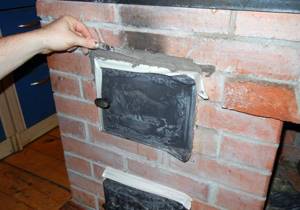
How to repair a brick stove with your own hands if these requirements were not met and cracks appeared? Such cracks are sealed with a solution containing fireclay. In case of major damage, the structure is disassembled, the fastening wire is tightened and the metal is wrapped with a heat insulator.
Recommendations from experts
The main task of the paint is to create an attractive appearance for the brick and protect the surface. No matter how high-quality the product is, over time cracks appear on the painted layers. This is a common decomposition reaction of the substance, but the period can be increased if the painting is carried out correctly and you take into account the advice of experts:
The correct choice of what paint to paint the brick stove in the house is the main point that will eliminate minor nuances in the future. You should not buy cheap products. Such savings will require double costs in the future.
One of the ways to dilute paint in a separate containerSource sdelalremont.ru
If the paint is too thick, then it must be diluted only with a solvent. The density of the fresh substance should be kefir mass. This composition will not require dilution and will not spread during application. To increase the strength of the mixture at home, it is recommended to add 40-50 g of table salt per jar.
It is important to first dilute it in warm liquid. If there are old layers of paint or lime on the stove, they should be removed. The limescale composition can be easily removed with water, and soft sandpaper can be used to remove paint. When purchasing brushes, you should not save money on them.
It is better to buy a wide tool with natural bristles. When purchasing them, you should check them and touch the fibers. They should be soft but elastic. If you decide to use a roller, it should be made of foam rubber or short-pile fur. Many paint manufacturers write on the packaging that it is enough to apply one coat of paint, but experts advise working in three stages. First, a “rough” layer is applied, then the main one, and only after that the finishing layer.
Applying the first layerSource gidpokraske.ru
- Do not mix several types of enamels. It is prohibited to apply paint and varnish without first preparing the surface.
- Before buying paint, it is better to calculate the oven area to find out how much dye to purchase. This will save money.
After completing the work, it is better to close the room for a day and, if possible, not enter there. After 24 hours, you can already go into the room to check the condition of the stove and open the windows for ventilation.
When choosing what to coat a brick oven with and with what tools, pay attention to all types of paints in cans or bottles, except those in aerosol cans. The composition sprayed with their help lies unevenly on the surface of the oven, and additional layers will lead to differences in shade.
Result of painting after applying the third layerSource centr-terrasnoi-doski.ru
Restoration and decoration
You can decorate the stove with the following materials:
- Heat-resistant tiles. This type of tile must be laid on a clean and level surface, using construction crosses for the seams. The tiles can be combined with various bas-relief edgings and frescoes. The advantages of the tile are obvious: it is easy to care for, and it also maintains a presentable appearance for a long time.
- Coating with enamel paint. The walls of the oven are covered with white paint, which reacts well to temperature changes. You can apply drawings to the main background with paints, using stencils, or paint the stove with aerosols. But it should be taken into account that when enamel paint is heated at first, it will emit an unpleasant odor, which will go away over time.
- Whitewash or lime. Add salt to the lime and water mixture to give the stove a snow-white shine and shine. Whitewash and lime are natural antiseptics that have a beneficial effect on human health and do not emit harmful substances.
Serious problems
Sometimes the damage to the brickwork is so serious that in order to restore the functionality of the heating system, individual parts will have to be completely replaced. Most often, craftsmen have to change the lining of the firebox, which consists of fireclay bricks.
If there are serious faults, you should entrust the repair to specialists
If the damage is not global in nature, then you can cope with the task directly through the firebox window. For restoration you need to use a fireproof mixture. All defective areas are carefully covered with it.
In case of serious damage, some of the bricks will have to be replaced. This must be done in the following sequence:
- Prepare the repair mixture in advance.
- Soak and remove the old mortar in the area where the brick will be replaced.
- Remove damaged lining elements.
- Thoroughly clean the vacated areas, moisten them with water and lubricate them with the repair mixture.
- Install new fireclay bricks and carefully seal the seams with refractory mortar.
When replacing individual lining elements, you need to ensure that the new brick is homogeneous with the old one. Otherwise, due to the difference in thermal expansion, the destruction of the furnace protection will continue.
It is possible to completely replace fireclay bricks in a firebox only by completely disassembling the wall. This is a difficult job that should not be performed without experience, as there is a risk of serious damage to the underlying masonry.
Serious repairs also include repairing the chimney and switching the brick stove to a different type of fuel. In the first case, you will have to go through the masonry and re-plaster it. In the second, you will need to completely redo the firebox.
Major renovation
These types of work include the following: replacement or repair of failed elements, as well as the return of a furnace that once lost its functionality. Many people think that such a reconstruction can only be done by an experienced stove maker, but in fact it can be done with your own hands.
If it is necessary to replace the lining, experts do not advise touching the main masonry. The furnace wall must be dismantled from the bottom of the ash pan to the height of the firebox, without touching the ribs, then cleared of rubble after dismantling the old lining, and laid out a new one without fastening it to the masonry of the walls. The thickness of the seams should not exceed 2 mm.
The upcoming transition of the stove to another type of fuel is a serious task, and each stove maker solves it in his own way. As an example, here is one of the methods. First you need to lay out the walls of the firebox using fireproof bricks . In this case, be sure to use a solution that can withstand high temperatures and open fire. The sides of the firebox must be equipped with small slopes so that at the time of combustion the coal falls down, covering the grate. In this case, it is important to use only high-quality bricks.
If you have to repair a sauna stove , then it needs to be done in the same way as restoring a conventional heating device. The difference is in the prevention, which a sauna stove needs more often: this is due to a higher temperature regime. In this case, special attention should be paid to both the fire resistance of the brick and the mortar. If the stove is broken, it is prohibited to use the stove until it is replaced with a new one.
Typical questions when repairing a stove yourself
How to seal cracks?
To begin, the cracks need to be cleared to a depth of 20-40 mm and all old mortar removed. After this, the cleaned surface must be moistened with plenty of water. To clean cracks, you need to add salt and asbestos powder in small portions to the clay solution, then carefully rub all the holes with the resulting mixture.
Before laying a new brick, the cracked one must be removed from the seat and the place for the mortar must be cleared. The new brick must match the dimensions, otherwise after a while it will also need to be changed. The masonry site and the new brick must be moistened with plenty of water, then spread with a clay solution and put in place.
Most cracks occur near the stove door. In order to compensate for the expansion of cast iron fittings, a sealant is used - a ceramic heat-resistant cord. Feel free to check its quality in the store to avoid counterfeiting.
The area around the fittings must be cleared and washed with a mixture of water and heat-resistant glue (1:1). After this, you need to lay the cord around the perimeter and treat it with a solution, adding a small amount of heat-resistant glue or cement to it in advance.
If you have problems finding such a cord, you can replace it with basalt or felt.
Minor repairs
Weak draft or its absence can occur, for example, due to the accumulation of a large amount of cold air in the chimney during a long break in the operation of the stove. There are other reasons: obstruction of the chimney (clogged with soot) or gusty wind outside; perhaps there is no air flowing in, the influx of which could support combustion.
In this case, you need to light the fire not with paper, but with dry fuel (a piece of rubber will do), but you should not use fuel (kerosene and others).
If more than a year has passed since the soot was “burned out” in the chimney, most likely it will be clogged. To eliminate this problem, you need to act like this: first try to get rid of the soot by pouring a little coarse salt into the burning stove and immediately closing the damper. As it burns, the soot will begin to crackle violently, and pieces of it will begin to fly out of the chimney. If this method turns out to be ineffective, you will have to use manual cleaning - there is a special door for this.
One of the signs that cracks have formed in the brickwork is strong smoking from the stove. In this case, the seams need to be patched with a clay-sand mixture, adding salt and crushed asbestos fiber to the solution. The last ingredient is used for the elasticity of the solution. The consistency of the mixture should not be very viscous, but not liquid either: after drying, a solution that is too greasy will crack, and a solution that is too thin will not provide the required strength, which will lead to the destruction of the masonry. To save time, you can not prepare the mixture yourself, but purchase a ready-made one. It comes with instructions, following which you can easily and quickly dilute the solution and do all the necessary work.
Another problem is the need to replace old, burnt bricks with new ones. To do this, the place must first be prepared: remove dust and clay, moisten it, then place a clay cake there. Then a new one is placed in place of the burnt brick, having first immersed it in water and applied a clay mixture to it both on top and on the sides - this will help make the seams stronger. The solution must be used the same as when sealing cracks.
Cracks
Before you start filling up the cracks, you need to understand the reasons for their appearance. The cobwebs that appear on the surface of the brick, which are shallow but spoil the appearance, will require a new coating. Cracks in cast elements may indicate the need for restoration work. Large and deep cracks inside and outside are a reason to think about possible flaws in the design and pouring of the foundation. Consultation with a specialist will be warranted.
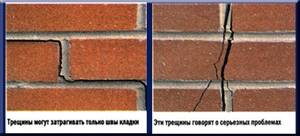
Individual gaps between slabs, doors and masonry can be easily eliminated using basalt cardboard. Lubricated with heat-resistant mastic, it perfectly covers cracks.
Reasons for appearance
The appearance of cracks in the stove mass is often attributed to the cold in the room and infrequent heating, which is not entirely true. In fact, the main reason is the coefficient of thermal expansion. Each material has its own, and large differences in values lead to deformation of brick, mortar, and masonry.
It is easy to prevent such defects by choosing the right masonry mixture. For red brick, use a mortar based on red clay; for fireclay stone, use fire-resistant mixtures with it.
The second common case is the natural shrinkage of the clay mixture, which usually appears in the first year of operation. Whatever additives are added to the solution, volume fluctuations after the fastening composition has dried cannot be reduced to zero. The minimum value is 6%, the figure is small, but such a difference between the original sizes is enough to cause cracking.
How to seal cracks (choice of mixture)
To reconstruct individual areas, choose a mixture based on the clay that was used to make the bricks. This can be a ready-made packaged product or prepared independently. The purchased option saves time on completing the work; the main thing is to carefully follow the instructions on the packaging.
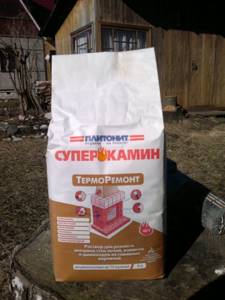
If you decide to make the restoration composition with your own hands, keep in mind that the thickening agent for fireclay mortar will be fireclay grain, while for clay mortar it will be sand. To improve the adhesion of the mixture, add regular salt; 1 kg per 12 liter bucket will be enough. The viscosity of the mixture should be medium so that the drying surface does not crack again.
Introducing reinforcing components into the coating will give the future patch strength; use a mixture of soaked asbestos for this. It is prepared simply; a sheet of material is soaked in water for about 15 minutes, turning into a liquid substance. Add no more than 2 liters per bucket of putty.
If you are not afraid of experiments, try making a restoration composition using the old method:
- crushed clay and wood ash in equal proportions;
- a quarter of table salt;
- water.
The doughy putty hardens quickly when the oven heats up. The composition is unusual in the absence of a sand component, but the resulting strength is good.
How to cover up
If you need to patch small cracks, then dismantling the masonry is not required. The stove should be heated, then the seams between the bricks will expand. We get rid of the old solution and apply the patch to a previously dust-free and moistened area. The composition is laid into the seam with a trowel and compacted with the edge of the tool.
If new cracks appear during the drying process, grease until the surface hardens without the appearance of cracks.
Current repairs: prevention of serious damage
Professionals strongly recommend that you carefully inspect the condition of your home fireplace before the start of each heating season. Timely repair of stoves and fireplaces prevents accidents and fires.
Troubleshooting minor problems
Any owner can carry out minor repairs to a stove in a country house or in a residential building, even if he does not have construction skills.
- Scuffs that appear on the pre-furnace sheet make cleaning difficult and can cause a fire. The leaky metal must be removed, the flooring must be protected with a sheet of asbestos and roofing steel of the required size must be nailed on top.
- To replace the grate, you need to remove the old part from the furnace and clean the area of soot. The new grille should be exactly the same size as the failed one. It is laid in place without mortar in the same way as the old grate bars.
- Twice a year it is necessary to inspect the chimney for foreign objects and debris. To clean soot from channels, it is recommended to use special chemicals.
Renewing masonry joints
Leaky seams spoil the appearance of the brickwork and allow harmful gases into the room. To detect weak areas, it is recommended to heat the stove - this will make large cracks visible. To eliminate the problem, it is necessary to clear the seams by 2-3 cm, after soaking them with water. Next, the walls are washed well with clean water using a brush.
The resulting depressions are filled with new clay mortar, carefully compacting the mixture and wiping out the voids. To increase the resistance of the solution to cracking, you can add a little table salt to the clay - 300–350 grams per bucket of solution. It is recommended to seal wide cracks with fire-resistant cord. If necessary, the walls are plastered and whitewashed or tiled.
Sealing of the combustion door and hob
The gaps that form between the doors and the masonry due to mechanical loads and thermal expansion also begin to let dangerous gases into the room. Do-it-yourself oven repair in this case begins with cleaning the surface and removing the old mortar. The cleaned area is washed and primed with heat-resistant glue diluted in the same volume of water.
A sealing asbestos or ceramic cord is attached around the perimeter of the door - it protects the clay from cracking, compensating for differences in the thermal expansion of materials. To avoid buying a fake instead of a fire-resistant cord, experienced stove makers recommend setting fire to your purchase without leaving the cash register. Next, the area around the door is rubbed with a repair solution and left to dry for at least a day.
Similarly, the gaps that appear between the hob and the walls are eliminated. To remove the stove, the stove should be heated a little, and then pry off the cast iron with a hard metal object, such as an ax. Instead of a cord in this case, you can use basalt wool or felt. If possible, the old stove can be replaced with a more modern one.
What to do if cravings worsen?
Good stable draft is necessary to maintain the correct combustion mode, which requires the supply of the required amount of oxygen to the firebox and the unhindered removal of combustion products - smoke, soot, soot, as well as gases formed during the combustion of fuel.
During the construction of the furnace, gas ducts (chimneys) of the required size are installed, capable of passing the amount of smoke that is generated during the combustion of fuel. But, over time, a thick layer of soot accumulates on the walls of the flues, which reduces the cross-section of the chimney and prevents the free passage of exhaust flue gases, creating additional resistance to their movement.
As a rule, the appearance of a large amount of soot is associated with the use of firewood containing a large amount of resinous substances, which do not have time to burn completely and fall out on the walls in the form of layers of soot. Damp firewood also produces a large amount of soot.
To improve draft in this case, cleaning the pipe that removes smoke from the firebox will help. You can read how to do this in the article “How to clean a bathhouse chimney.” Also, the draft may be disrupted due to leaks in the stove lining, cracks in the walls and in the masonry of the chimney. Moreover, destruction of the masonry can occur not only within the heated room, but also outside the building - if the pipe masonry on the roof cracks and collapses, the draft will also be disrupted. How to eliminate cracks that appear, read below.
Get rid of excess
Where to start repairing a brick stove? First you need to dismantle the firebox, the design of which has serious errors. It is necessary to take into account that when working in a residential building, you need to remove or cover objects with a layer of polyethylene. After dismantling the slab, it became clear that about 80% of the brick had become unusable.
The chimney cleaning channel is located at the bottom, and the smoke exhaust channel is located at the top. During the work, you need to place the firebox so that the chimney is not on the side, but directed towards it.
The next step is to remove the flue door located at the bottom of the stove. In addition to the possibility of them falling out, the chimney hood shafts needed to be cleaned.
You also need to get rid of the casing (the chimney cover at the top of the stove). The task of the master in this case is to reduce the number of bends in the chimney. Their cleaning is impossible due to the lack of a cleaning hatch. The deterioration of this place is associated with a large amount of soot, which, as if falling into a zone of turbulence, accumulated in the chimney channel, and over time hardened. And since cleaning was impossible, this only made the situation worse. The open chimney casing resembled a blood vessel clogged with cholesterol. The smoke escape was provided only by a narrow gap, as a result of which it rose high above the firebox. The casing must be dismantled in such a way that the old masonry meets the new masonry.
To remove the furnace view, you need to disassemble the masonry located above the casing.
pechnoedelo.com
How to prevent cracks in your cooktop
In heating and cooking stove designs, the “sore spot” is the cast iron hob. Cracks in the panel themselves do not interfere with the operation of the stove. If it is folded correctly, it has good traction and cracks do not cause any inconvenience. But - for the time being. If the design of the stove is broken or there are errors in the masonry, then carbon monoxide can leak through these cracks. And this is a big threat to the lives of people who are in the room.
As a rule, high-quality cast iron panels almost never crack. But it's better to be safe.
In order to prevent cracks from appearing on the panel, the first heating of the stove with a new hob is done carefully, warmed up slowly, without loading the entire firebox. To distribute heat evenly over the panel, pour a thick layer of sand on it, or lay out a brick
Remove the sand or remove the brick from the panel only after it has completely cooled. A uniformly loaded panel will “sit down” without distortions, which means there will be no “stress” cracks in it.
Heating in the house
The heating system can have several types:
- The room is heated only by a small stove with a hob. This option is suitable for a small space, as well as in cases where you rarely visit the dacha.
- Heating using a heating system in the form of pipes passing through the furnace. In this option, heat is accumulated and distributed through pipes filled with antifreeze or water. The option is perfect for heating a room of 40 m2, but you should take into account the features and costs (you need to purchase a pressure meter, a pump, supply water to the house, etc.).
- Heating the room using a fireplace. The fireplace gives off heat well during the burning of wood, but does not retain it. This option is suitable for quickly warming up a room to room temperature, but it is not profitable to use it all the time.
- An ordinary stove is rough or potbelly stove. This type of stove does not take up much space and is the most economical option for a summer resident. The efficiency of this type of furnace is very high - this is due to its structure and the presence of many passages.
Russian stove on the street
Both the construction of a Russian stove outside the home and its operation have their own peculiarities. They are caused by more aggressive effects of atmospheric phenomena during the combustion process and during long winter downtimes. A stove left in the cold for at least a few days without use will warm up unevenly from the sun's rays. And masonry joints are saturated with atmospheric moisture.
When melting for the first time after a break, you need to use a small amount of wood chips. The gases coming out of the pipe should become transparent, which takes an average of one and a half to two hours. After this, you can lay regular firewood.
With barbecue
The primitive design of a stationary outdoor barbecue involves an open brick box on one side with a chimney tapering upward. This option is closer not to a Russian stove, but to an English fireplace.
To build a more labor-intensive but effective Russian-style outdoor fireplace, you will need much more brick. The diagram for laying a Russian stove on the street with your own hands is shown in the figure:
Layout of a Russian stove on the street with your own hands
This device performs the functions of an ordinary hearth structure equipped with a grill for cooking over coals.
In the gazebo under the canopy
For the construction of a stove in non-permanent wooden buildings (verandas, gazebos, covered terraces), fire safety requirements become relevant. A non-combustible belt must be created around the masonry: at least 30 cm from the walls and 60 cm from the door. A heat-resistant material is suitable for this - sheet asbestos cardboard with a thickness of over 4 mm. The top should be sheathed with roofing iron.
Bread baking oven
The construction of a wood-burning baking oven can have a simplified design. Many of the requirements for a traditional hearth are optional for this type of stove.
The most important requirements:
- the combustion chamber is large enough to fit a tray with molds inside;
- a pronounced spherical arch so that thermal radiation is focused in the center of the furnace and maintains the desired temperature.
Placing a bread oven outside allows you to not lay out the outlet channels very carefully. After all, the threat of carbon monoxide poisoning in the fresh air is much less than indoors.
How to build outdoors
The main feature of designing an outdoor stove is the need to provide protection from atmospheric moisture. You will need to build a reliable canopy. A rafter structure is erected for it on wooden or metal poles. You can arrange a power system by welding metal. The main requirement: the ability of the canopy to support both its own weight in windy weather and the snow load in winter.
See the problem
When inspecting the furnace, the following facts may be revealed:
- The device does not have an additional blower, the so-called letnik, which enhances the stove draft when it is lit.
- Changing the location of the blower: instead of the lower part of the firebox (under the door), it is located at the end of the stove.
In addition, there may be no additional hood above the hob, and the heating of the room is less on the side where another wall is located. These errors also need to be corrected.
The second disadvantage is the location of the view relative to the smoke channel going up. From an ergonomic point of view, this valve cannot be positioned horizontally all the time. This leads to disruption of its operation or, as stove makers aptly put it, to “tears of the stove.” The fact is that in winter, especially during frosts, a lot of condensate accumulates in the equipment, which, mixing with soot, turns into a solution of high concentration carbonic acid, which leads to the gradual destruction of the masonry.
So, thanks to an external inspection, it was possible to identify problem areas that need to be worked on. After this, you can begin repairing the brick oven with your own hands.
More complex repair work
You can save on stove repair services not only during routine repairs, but also when carrying out major work to eliminate serious problems. You can also do it yourself by re-installing the firebox, replacing the fire door, restoring the masonry and solving other problems. In this case, only specialized mortar and refractory materials should be used in order to prevent additional problems from arising when operating a Russian brick kiln.
Partial and complete relocation of the firebox
Despite the properties of refractory brick, over time it becomes unusable, so timely replacement of this component of the structure is also necessary. Rebuilding the firebox with your own hands is a rather complicated process and is often entrusted to a professional stove maker, but in order to save money, you can carry out a major overhaul of the stove yourself.
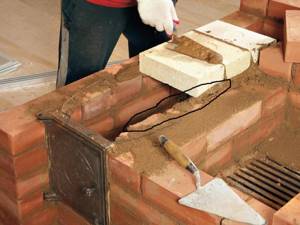
If the structure reveals minor damage in several bricks, then a complete relocation of the firebox may not be necessary, making only a partial replacement. For this purpose, damaged parts in the masonry are removed and, after cleaning the surfaces, a new masonry is made using a special solution.
Relining the lining
Relining is one of the most common types of major repairs. In its production, exclusively fireclay bricks are used. It should be remembered that the refractory masonry should not come into contact with the brickwork of the firebox body.

Replacing the fire door
To avoid reducing the overall efficiency of the design, you should purchase new parts with the same parameters and dimensions as the old ones. This also applies to the firebox door, which is most often made of cast iron. When buying a door, measure the old one and when purchasing a new one, compare them in size. Also remember about the need to use exclusively specialized solution for fireplaces and stoves.
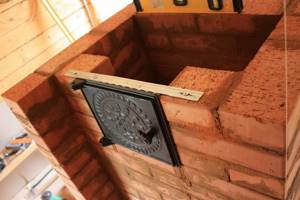
Dismantle the old part along with the frame, clearing as much space as possible for the new door. Then you can start replacing it:
- Clean the masonry from old mortar;
- Attach the steel tabs to the new cast iron piece and install it so that the strips are inside the masonry seam;
- A pre-purchased cord with fire-resistant properties should be laid between the stove masonry and the door frame;
- All gaps are filled with a special solution;
- The composition is allowed to dry for 1-2 days.
Brickwork repair
In a Russian stove, frame brickwork is rarely damaged, since it itself does not come into contact with fire and is not in danger of being damaged due to temperature changes. But if the stove maker did the repair work incorrectly, then it too may be damaged. Frame restoration is a simple type of repair; it does not require specific skills or specialized materials.

